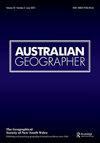谁对城市有权利?公园、停车场和大学参与城市场所建设
IF 2
2区 社会学
Q2 GEOGRAPHY
引用次数: 0
摘要
街景是由人们在地方的归属和在空间之间的运动所塑造的城市地理之一。这样的地理位置表达了关于城市权利的强大理念。看看国际公园日吧,在这一天,人们通过替换车辆和建造小公园来回收街道上的停车位。然而,当停车场的安装导致停车位的长期流失时,人们也受到了批评。本文的目的是在一个涉及一所正在进行重大变革的大学的案例中分析这种争论。作为场地规划策略的一部分,该大学试图在中央商务区的市政街道上创建一个公园,靠近新的专门建造的学生宿舍。在很短的时间内,这个想法遭到了该市特定利益相关者的抗议,该大学后来撤回了市政开发申请。正如我们在对新闻报道和评论的分析中所指出的那样,这个案件的意义在于,公园公园是关于谁拥有这座城市的权利和大学职能的深刻分歧的牺牲品。世界各地的城市也存在这样的分歧,可以说,这破坏了支持去碳化未来和关怀基础设施的小行动,而这些行动迫切需要更大的社会和环境收益。本文章由计算机程序翻译,如有差异,请以英文原文为准。
Whose rights to the city? Parklets, parking, and university engagement in urban placemaking
Streetscapes are among the urban geographies shaped by people’s belonging in place and movements through the spaces-between. Such geographies give expression to powerful ideas about rights to the city. Witness international PARK(ing) Day, during which people playfully reclaim on-street parking areas by displacing vehicles and creating parklets. Yet, parklets have been criticised when their installation results in long-term loss of parking spaces. The purpose of this paper is to analyse such contestation in a case that involved a university undergoing significant transformations. As part of its place-making strategy, the university sought to create a parklet on a municipal streetside in a central business district near new purpose-built student accommodation. In short order, the idea was protested by particular stakeholders in the city, and the university later withdrew the municipal development application. As drawn out in our analysis of news reports and comments, the significance of the case is that the parklet was a casualty of deep divisions about who has rights to the city and about the functions of universities. Such divisions also exist in cities around the world and arguably undermine small actions to support decarbonising futures and caring infrastructures that attend urgently needed larger social and environmental gains.
求助全文
通过发布文献求助,成功后即可免费获取论文全文。
去求助
来源期刊

Australian Geographer
GEOGRAPHY-
CiteScore
4.10
自引率
8.30%
发文量
33
期刊介绍:
Australian Geographer was founded in 1928 and is the nation"s oldest geographical journal. It is a high standard, refereed general geography journal covering all aspects of the discipline, both human and physical. While papers concerning any aspect of geography are considered for publication, the journal focuses primarily on two areas of research: •Australia and its world region, including developments, issues and policies in Australia, the western Pacific, the Indian Ocean, Asia and Antarctica. •Environmental studies, particularly the biophysical environment and human interaction with it.
 求助内容:
求助内容: 应助结果提醒方式:
应助结果提醒方式:


